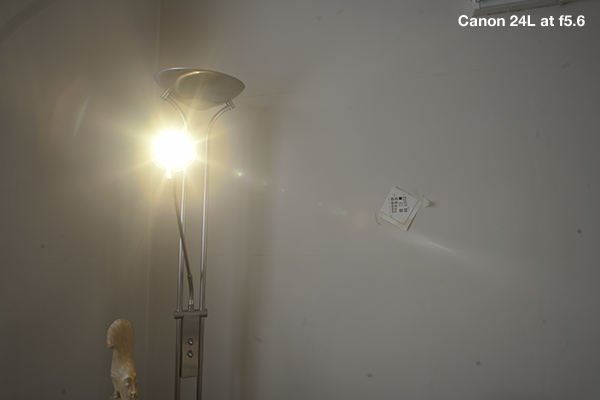[nextpage title=”Introduction”]
At last, it begins: the finest 24mm lenses on earth, each group finalist having proven its mettle against the best of its peers: the Canon 24mm f1.4 L – king of the fast primes; Nikon 17-35mm f2.8 AFS – still potent at 24mm (despite peaking at 20mm); against the boy from nowhere – the tiny, clearance-sale-price, gem-like Olympus 24mm f2.8.
The weather here at the Überjenaköchen stadium is pretty variable: some fast moving cloud causing difficulties for the referee, but we’ve waited long enough . . . the contenders for the title of the Best of the Best make their way onto the pitch . . .
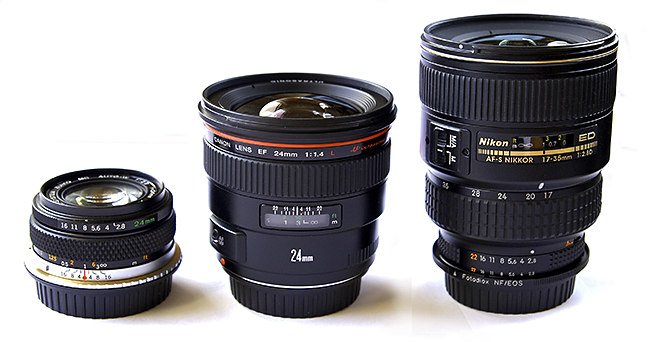
Oh, now we don’t like to see that: the crowd is actually laughing at the Zuiko . . . cries of ‘short aaaaarse, short aaaaarse’ are coming – I think – from . . . yes, it started in the Nikon supporters enclosure. Nikon remember, today field their two pound, five inch Sumo-style monster which steamrollered its way through the opening rounds through sheer mass . . . and now Canon takes up the chant: ‘she fell over . . . she fell over . . .’
Canon, you might recall, recently defended criticism that their professional players were overpriced and offered little entertainment value . . . warming up now in their black livery with the single red stripe, there’s a sense that they resent sharing the field with such humble opponents: indeed their 24L is so much faster than the opposition, many have questioned whether the result is a foregone conclusion. Certainly they look confident: twice the size, three times the weight and five times the price of the Olympus, they’re in good shape to face their long-standing foe, Nikon, and they must fancy their chances today.
The Canon has the home advantage, of course; both its rivals are playing away in Canon EF adaptors: FotoDiox Pro for the Nikon; CameraQuest for the Olympus. That could cause trouble later.
The Japanese anthem plays (three times); the players spit on the ground, readjust their groins, and cross themselves in anticipation. Let’s get the ball rolling.
[nextpage title=”Resolution (f2.8)”]
Performance at f2.8 (Centre Frame)

The following 100% crops are taken from the areas marked in red on the full frame image.
The Canon 24mm f1.4 enjoys a massive two stop advantage over its slower (f2.8) competitors who are crying ‘foul’ at this point. But the ref says play on . . .
 |
 |
 |
| Canon 24mm f1.4 L at f2.8 (centre) | Nikon 17-35mm at 24mm/f2.8 (centre) | Olympus 24mm f2.8 at f2.8 (centre) |
|
0 points
|
1 points
|
2 points
|
GOOOOOAAAL! Zuiko slams in a strike from the halfway line and the Canon L skies a penalty. Couple of points worth noting: the Olympus 24mm f2.8 did not perform anywhere near this well wide open with the oversized adaptor supplied; now it flies – though there is a distinct lack of contrast across the frame compared with the Nikon. However, it takes the points because its resolution advantage pulls more from the scene. Contrast is easily corrected.
So I fluffed the focus on the Canon shot, right? I thought so, too, at first . . .
Performance at f2.8 (Mid-Frame)
Note that the Canon 24L, away from the frame centre, is way sharper in front of – and behind – the steps in the previous shot.
 |
 |
 |
| Canon 24mm f1.4 L at f2.8 (mid-frame) | Nikon 17-35: 24mm/f2.8 (mid-frame) | Olympus 24mm f2.8 at f2.8 (mid-frame) |
Wow. It’s equally impressive right of centre, at the same distance from the centre frame . . .
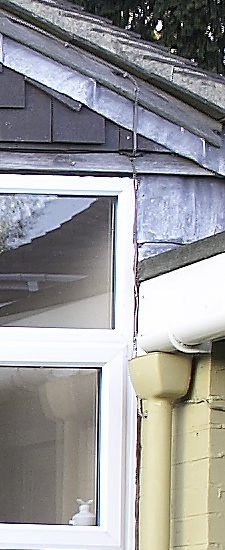 |
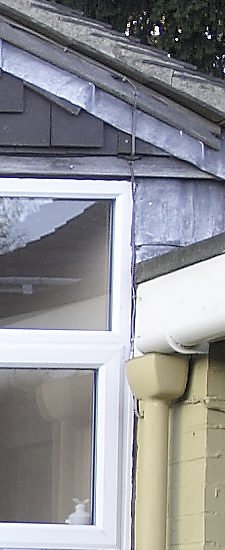 |
 |
| Canon 24mm f1.4 L at f2.8 (mid-frame) | Nikon 17-35: 24mm/f2.8 (mid-frame) | Olympus 24mm f2.8 at f2.8 (mid-frame) |
|
1 point bonus
|
What’s that about? Search me. Here’s an action replay: same aperture, different day. The corners on this shot aren’t quite as sharp as the ones you’re about to see, so maybe we’re seeing a waveform focal plane at this aperture. Or perhaps it was a rogue blob of moisture? At least we can’t blame the adaptor. Either way, the linesman has insisted on awarding the 24L an extra point. I have used this particular 24L at wide apertures in the field and not noticed any weirdness until I went looking for it here.


Performance at f2.8 (Corners)
Here we have to factor in a little sunlight to accommodate a rapidly moving British winter sky: the Nikon is somewhat disadvantaged by poorer light, but I resisted the temptation to re-shoot as it became evident that it wasn’t going to outperform either of its competitors’ corners, whatever the light.
 |
 |
 |
| Canon 24mm f1.4 L at f2.8 (corner) | Nikon 17-35: 24mm/f2.8 (corner) | Olympus 24mm f2.8 at f2.8 (corner) |
|
1 points
|
0 points
|
2 points
|
Look beyond the low contrast rendition of the Olympus wide open, and there’s a whole lot of captured information that – amazingly – neither lens can find.
What have we learned? Firstly – and for the first time in my testing – the Nikon zoom is being outplayed. At f2.8, the Canon 24L is very good when it’s good, but question marks linger over its Ronaldo-like behaviour. The Olympus 24/2.8 again exceeds expectations: wide open, it really delivers, across the frame, and requires only modest post-production perking to restore contrast – even if it can’t reach the dizzying heights of the Canon lens when it’s on form.
[nextpage title=”Resolution (f5.6)”]
Performance at f5.6 (Centre Frame)
Because this is the 24mm final, I was confident of achieving superb captures from each lens from hereon in – and they didn’t disappoint. By f5.6, each lens is producing crisp, attractive images with bags of detail, credible plasticity and no significant gremlins.
 |
 |
 |
| Canon 24mm f1.4 L at f5.6 (centre) | Nikon 17-35: 24mm/f5.6 (centre) | Olympus 24mm f2.8 at f5.6 (centre) |
|
0 points
|
1 points
|
2 points
|
But centre frame, the Olympus delivers Zeiss-like levels of microcontrast and detail. Performance here is on par with the all-conquering Distagon 21mm and in a different league from the Nikon zoom and the Canon prime, which still appears to be off the pace in the middle of the field. Down the wing, it’s a different story.
Performance at f5.6 (Mid-Frame)
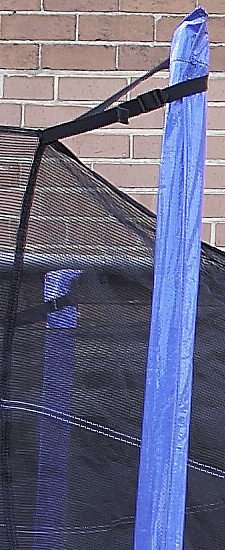 |
 |
 |
| Canon 24mm f1.4 L at f5.6 (mid-frame) | Nikon 17-35: 24mm/f5.6 (mid-frame) | Olympus 24mm f2.8 at f5.6 (mid-frame) |
|
2 points
|
0 points
|
1 points
|
Exceptionally fine rendition by the Canon: beautiful colouring, and every stitch in the netting visible. Once again, the Nikon 17-35mm is slightly edged out by the Zuiko 24mm. If only the fast L was as good in the middle.
Performance at f5.6 (Mid-Frame II)
 |
 |
 |
| Canon 24mm f1.4 L at f5.6 (centre) | Nikon 17-35: 24mm/f5.6 (centre) | Olympus 24mm f2.8 at f5.6 (centre) |
|
2 points
|
0 points
|
1 points
|
A second sample from the mid-frame, this time on the right side, shows that all these samples are at least properly centred. The Canon 24L maintains its advantage here, followed by the Olympus and Nikon in close competition. Moving on to the upper left corner sorts the men from the boys.
Performance at f5.6 (Corner)
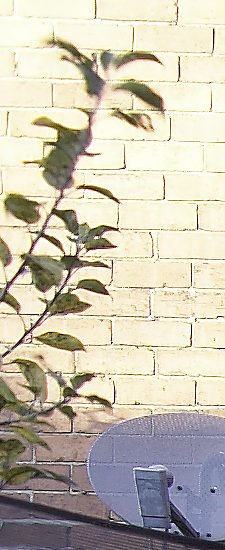 |
 |
 |
| Canon 24mm f1.4 L at f5.6 (mid-frame) | Nikon 17-35: 24mm/f5.6 (mid-frame) | Olympus 24mm f2.8 at f5.6 (mid-frame) |
|
2 points
|
0 points
|
1 points
|
Stupid sun. If we concentrate of the mesh of the satellite dish rather than the brickwork, whose lighting variation makes comparison almost pointless, the Canon and Olympus primes are outperforming the Nikon zoom, though the 24L evidently extracts more high frquency detail from the corners than the Zuiko. To illustrate this better, let’s consider a different subject at f8 . . . .
[nextpage title=”Resolution (f8)”]
Performance at f8 (Extreme Upper Left Corner)
 Canon 24mm f1.4 L at f8 (corner)
Canon 24mm f1.4 L at f8 (corner)
 Olympus 24mm f2.8 at f5.6 (centre)
Olympus 24mm f2.8 at f5.6 (centre)
 Nikon 17-35: 24mm/f5.6 (centre)
Nikon 17-35: 24mm/f5.6 (centre)
Rather than attempt to even out the framing differences, this represents the extreme cornermost section of each image at 100%. Before writing off the AFS 17-35mm altogether, in its defence I must point out that the Nikon’s performance deteriorates from 24mm to 35mm: it’s considerably better in the corners at 20mm / f8, for instance. In this it is opposite to the Canon 16-35mm L which from 28-35mm is an exceptionally fine lens, but which isn’t competitive at shorter focal lengths.
The crunch question here is calling the tackle made by the Canon L on the Olympus 24mm. The crowd’s sympathies lie with the underdog Zuiko rather than the overpriced glamourboy with the red bandana . . . but the linesman and ref have conferred and agree on what may be a decisive verdict: TWO POINTS for team Canon; ONE for Olympus and nothing for Nikon. The 24L is close to perfect to the cornermost pixel – at last! one, solitary, lens at this focal length that can live with with demands made Canon’s full frame sensors.
[nextpage title=”Resolution (f11)”]
Performance at f11 (Centre Frame)
 |
 |
 |
| Canon 24mm f1.4 L at f11 (centre) | Nikon 17-35: 24mm/f11 (centre) | Olympus 24mm f2.8 at f11 (centre) |
|
2 points
|
1 points
|
0 points
|
What a shame: the referee’s decision about the f8 tackle on the Japanese/Brazilian Zuiko has completely put team Olympus off its rhythm. A sulky performance like this f11 doesn’t do them any credit and, frankly, it’s not good for the sport. As if to add insult to injury, the Canon 24mm lifts its game with a scorching performance at this aperture, smashing the diffraction-y Olympus which is even outperformed by a outstanding late run from the Nikon.
Performance at f11 (Mid-Frame)
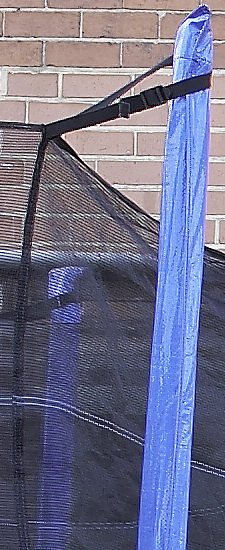 |
 |
 |
| Canon 24mm f1.4 L at f11 (mid-frame) | Nikon 17-35: 24mm/f11 (mid-frame) | Olympus 24mm f2.8 at f11 (mid-frame) |
|
2 points
|
1 points
|
0 points
|
I rather fear it’s all over for the Olympus, which came such a long way on such a limited budget. The little fella is looking absolutely shattered: stumbling all over the middle of the park against competition which has the legs to turn in stronger performances at this aperture, even in the corners (just about).
 |
 |
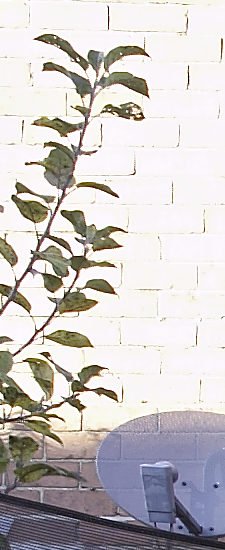 |
| Canon 24mm f1.4 L at f11 (corner) | Nikon 17-35: 24mm/f11 (corner) | Olympus 24mm f2.8 at f11 (corner) |
|
2 points
|
1 points
|
0 points
|
[nextpage title=”Distortion”]
Geometric Distortion / Close Range Performance Test
The distance to each brick wall was approximately one metre; the aperture f8. Rollover each image to make A-B / B-C / A-C comparisons.
The Nikon’s pincushion distortion at 24mm (it is dead neutral between 20-22mm) is problematic to correct, particularly given that the worst effects are concentrated in the outward-sweeping corners, where the resolution is already relatively poor and doesn’t need further corrective interpolation. The Olympus suffers from the greatest degree of distortion (barrel), but it is almost linear in nature, and easily fixed by CS3 lens tools, or even a simple Spherize, without smearing fine detail. The Canon’s modest waveform distortion looks like barrel distortion in the middle of the image circle, but turns outwards slightly at the edges. For most applications, Spherize will do the trick, and in many instances will not be required at all.
At a distance of one metre, we see no significant reversal of the earlier results shot with the focal plane at a distance of approximately 12 metres. All the finalists appear to be as well corrected for close range work as they are for landscape duty – surprising, given that the f2.8 version of the Olympus 24mm doesn’t have floating elements for close range correction. The Nikon 17-35mm possibly claws back a little of the ground it lost earlier to the Olympus at near distance, but the difference is negligible.
Close Range Performance: f8 (Centre Frame)
 |
 |
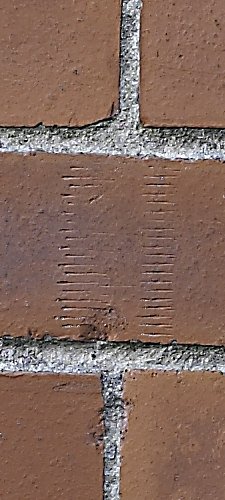 |
|
Canon 24mm f1.4 L at f8
|
Nikon 17-35 at 24mm at f8
|
Olympus 24mm f2.8 at f8
|
|
2 points
|
1 points
|
0 points
|
Close Range Performance: f8 (Extreme Upper Left Corner)
 |
 |
 |
|
Canon 24mm f1.4 L at f8
|
Nikon 17-35 at 24mm at f8
|
Olympus 24mm f2.8 at f8
|
|
2 points
|
0 points
|
1 points
|
The Canon still owns this aperture, showing none of its mysterious centre frame softness at wide apertures. Note the significantly greater geometric distortion in the corners of the Nikon 17-35mm shots. The Olympus 24mm is neutral in this regard but barrels out across the centre frame.
[nextpage title=”Chromatic Aberration”]
Chromatic Aberration Comparison
Even well stopped down, all but the very best retrofocus wide angle lenses suffer from (usually lateral) chromatic aberration. This is commonly manifest as blue/yellow or purple/green colour fringing wrapped around both sides of contrasty in-focus objects. Black on white transitions, such as brickwork or fine branches against cloudy skies, frequently cause problems, as they do to a greater or lesser extent for all our finalists. The following samples are screen shots from 200% views.
 |
 |
 |
|
Canon 24mm f1.4 L
|
Nikon 17-35 at 24mm
|
Olympus 24mm f2.8
|
|
0 points
|
1 points
|
2 points
|
Even at f8, the Nikon zoom suffers from the blue flavour of lateral CA, whereas the Canon and Olympus primes have invasive reds and purples. In practice, the fringing is observable in many shots with the Nikon and Canon lenses, but you really have to go looking for it with the Olympus. Take for example these screen shots: the first are a detail at f5.6; the last one illustrates how much worse is the Canon 24mm’s CA problem at f2.8.
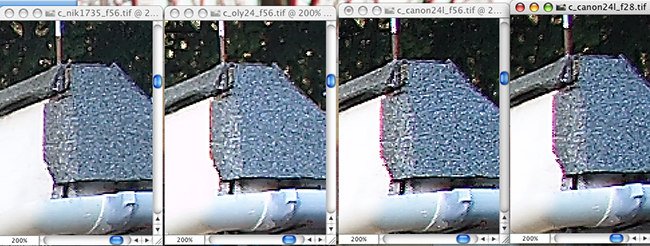
The Nikon shows moderate blue CA around objects positioned at the edge of its image circle; the Canon suffers even more severely, as the following image shows, shot at f2.8:
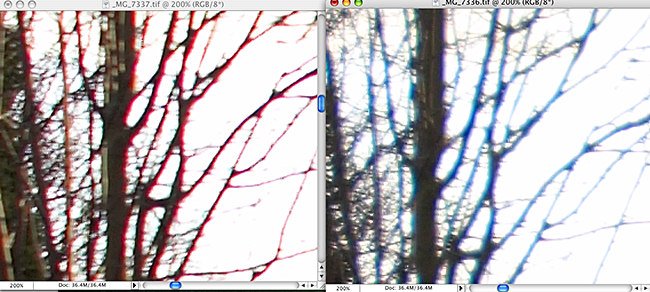
It’s very hard to make the Olympus misbehave in this way, so full marks to the Zuiko.
[nextpage title=”Fare & Ghosting”]
Flare & Ghosting / Internal Reflection: Part I
It seemed appropriate to begin a ‘take no prisoners’ final interrogation by making the finalists stare into bright lights – see what they’re made of, what? Here are full frame shots of each: note the differing artefacts produced by each lens. Roll over each image to make an A-B / B-C / A-C comparison.
We’re into the realm of the subjective here, but it doesn’t feel too contentious to award more points to the Canon L than the Nikon AFS, whose invasive ghosting is much less discreet. The little Olympus suffers from a different species of internal reflection, but in practice (preliminary, unpublished flare tests were shot into the sun) it is less distracting than the marching blobs produced by its bigger competitors here.
|
Nikon: 0 points
|
Canon: 1 point
|
Olympus: 2 points
|
Flare & Ghosting / Internal Reflection: Part II
That critical 20 minutes of blue light (following the grey half hour, which follows the golden hour) favoured by architectural photographers demands a lens that handles point light sources, such as streetlights, with aplomb. This particular aspect of flare control is dear to my heart, so there follows a comparison which may not be of general interest. There is a ‘next’ button at the bottom of the page.
For those who care, the Canon renders point light sources with an eight-pointed star at apertures from f4–f16. The Nikon produces a multi-pronged, finely-spiked starburst even at moderately wide apertures. The Olympus just glows.
 |
 |
 |
| Canon 24mm f1.4 L at f8 | Nikon 17-35mm at 24mm/f8 | Olympus 24mm f2.8 at f8 |
|
1 points
|
2 points
|
0 points
|
Perhaps more meaningfully, a close-up (100% actual pixels) view of each shows that the Nikon is retaining better contrast in its flare halo, winning this round not only because it’s pretty but because it captures more information.
[nextpage title=”Trophy Ceremony”]
The scores tally as follows:
|
Canon 24mm f1.4 L
|
Nikon 17-35 at 24mm
|
Olympus 24mm f2.8
|
|
25 points
|
9 points
|
16 points
|
In a way, I’m glad the Canon L scored so consistently across the board: because how do you factor in the very real, but untested, advantages it has over the competition? How many points does it deserve for doing everything the Zuiko does, but with auto focus? And how should it be rewarded for being able to get a picture at all at f1.4? That’s a whole stop faster than even the f2.8’s faster f2 sibling, which could equally well have taken its place in the final. Unlike the fast Sigmas, the Canon 24L’s widest apertures aren’t just there for show: in the last few months, I’ve obtained critically sharp images on full frame bodies hand held at f1.8 and f2 – even wide open it shines. Just for fun, see the Sigma 24/1.8 v Canon 24/1.4 test here.
It’s not perfect, of course: there’s its weird centre frame performance at wide apertures, and the worse-than-expected lateral CA, but on a full frame sensor, it clearly delivers higher resolution, right into the corners, than anything else you can put in an EF mount. Let’s also not forget that it makes a highly versatile 35/1.4 (with sharp corners?) on an APS-sensor body.
Inevitably, hovering above the results, is the spectre of sample variation. The US-spec lens I tested (sample 26686, UV marked on the rear element housing US0901) was not only a different lens from the one tested by photozone and castleman and Rob Galbraith, it may as well have been a completely different design. Where photozone found sharp centres and soggy corners at wide apertures, I found the reverse; and there’s no doubt in my mind that this 24L, at least, would flat out murder the 24mm Tilt/Shift I once owned. But such is the lottery of ownership: you pays your money; you take a chance.
The bald tally doesn’t also tell the story of how the Olympus and Nikon compare. The Olympus is astoundingly good at f5.6-8 at distance, and produced the highest resolution captures of anything shot thus far at 24mm. However, the Nikon gets is own back at f11 where the Zuiko is over the hill in diffraction terms.
We should also mention that the stellar little Olympus 24mm thrashed every other lens it encountered in the group stages of the 24mm World Cup, can be bought used for less than a decent filter for the 24L, and fits in the palm of your hand with room to spare. It’s a gem.
However, the day surely belongs to the Canon f1.4 L, undisputedly the finest 24mm on earth.
At least my one is.
Until the Zeiss ZF 25mm becomes available . . . .



